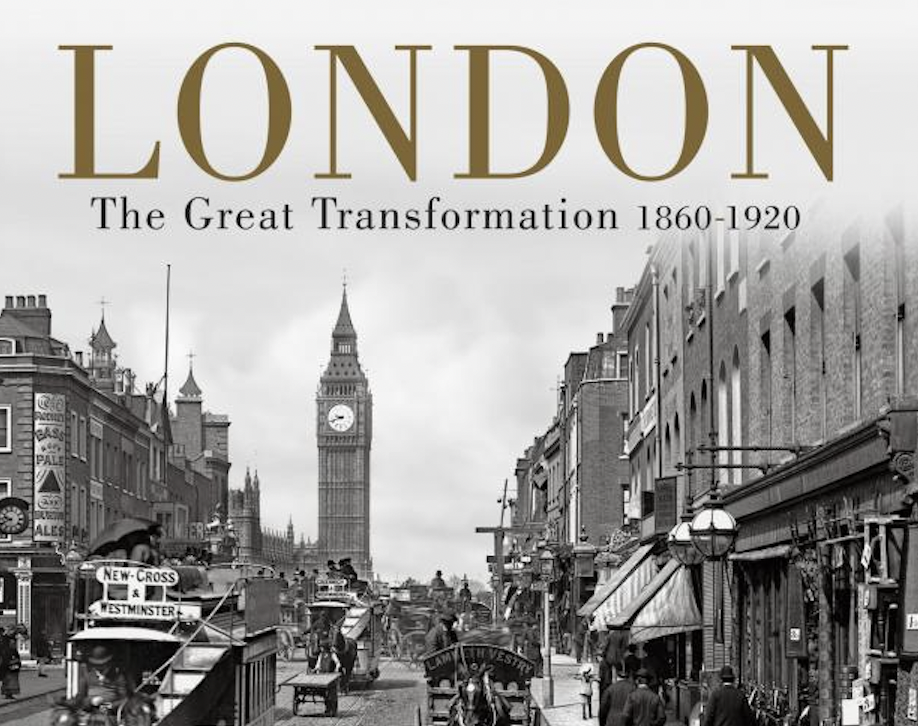Post
BOOK REVIEW | London: The Great Transformation 1860-1920
20 Jul 2023
By Philip Davies
Reviewed by Barry Coidan
Warning: do not be tempted to immerse yourself straight away in over 450 pages of wonderful photographs charting lost and transformed London in all its glory and glorious urban grime. I did and I was overwhelmed by the fantastic diversity. I went hither and thither, each photograph invoking different emotions.
The forward by Dan Cruickshank suggests that “…one of the great joys of this is that it includes…many views of obscure streets and buildings in which the majority of Londoners lived and worked and took their pleasure”. He ends the forward with… “the photographs allow lost London to be conjured back into existence so that, with a little imagination, we can walk its streets and gaze into the faces of long-lost generations of Londoners”. What an invitation!
Join today and get Priority Booking here at The London Society
The chapter Introduction: Chronicles of a Changing City” leads you through the development of photography and its use as the revolutionary recorder of change, people and places. This includes early images in the 1830s to capturing, in moving pictures, Queen Victoria’s Diamond Jubilee procession at St Paul’s Cathedral in the summer of 1897.
The chapter on A Tale of Two Cities reveals the huge gulf between the haves and have-nots in London over years of transformation. Compare the luxury that surrounded the upper middle classes with the squalor so many lived in. A confident city building anew, apparently careless about the fabric, history and the people destroyed and displaced by the Victorian’s brash “can do” attitude.
And then plunge into this deep sea of sepia and navigate around a London disappearing and being remade.
We begin in chapter one in the City of London and a photograph of busy London Bridge in the 1890s. There are top-hatted city gents, dressed in formal wear, no doubt heading to their well-appointed offices, or luncheon at their club. Middle managers and foremen in smart suits and bowlers. Flat-hatted drivers and labourers conveying the life blood of the city across the bridge. The Thames is alive with cargo ships, barges and warehouses.
Turn the page and you’re in Cloth Fair, a remnant of medieval London. A journey through narrow streets and tall houses. From survivors of the Great Plague and the Fire of London. Then moving on to Great St Bartholomew, Smithfield and Newgate Prison.
The “dreadful walls of Newgate which have hidden so much misery and unspeakable anguish” (Oliver Twist, Charles Dickens). From 1783 to 1868 public executions were held in the street outside the prison, sometimes as many as 20 at a time, attracting huge crowds. The photographs show a grim, forbidding façade. Inside: Newgate Prison Chapel, where those to be executed sat in pews in sight of their fellow prisoners to hear prayers for their souls. The photographs convey the crushing despair of the place.
Set in opposition to these dreadful sights are images of piety and prosperity. The many churches in the city, the grand institutional buildings on the corner of Threadneedle Street. The faces of porters of Billingsgate Market stare at the camera. The inns of the City, the grand railway termini – Liverpool Street and Fenchurch Street- busy, busy, busy – carrying city workers to and from the expanding suburbs.
The text accompanying each photograph is clear and concise, although I did, on occasion, have difficulty matching the photograph with the appropriate text.
The photographs cover twelve London districts, including the City of London, Westminster, Islington and Hackney, Tower Hamlets and Kensington and West London.
Highlights include The Northern Heights covering Crouch End, Hampstead, Highgate, Archway, Alexandra Palace and Hornsey.
Here, you could be forgiven in thinking you were in the countryside. Quaint cottages at North End where the painter John Linnell lived. The Bull and Bush public house, a haunt of cockneys and Jack Straw’s Castle, situated at the highest point in London and frequented by Thackeray, Wilkie Collins and Charles Dickens. (I attended a friend’s wedding reception there in the mid 1970’s).
Check out our rundown of upcoming events
There’s a lovely photograph of Andrew Marvell’s House on Highgate Hill, just before being demolished in 1868. The Archway Road tollgate and toll house, with the keeper and family posing outside, in 1870. Tolls were abolished in 1871. I couldn’t help but wonder at what happened to that large family.
I must mention Hornsey and a photograph of idyllic thatched cottages in 1888 – demolished in the 1920s as the developers rolled over the fields and woods. Also, Nightingale Lane in 1894, where residents stand proudly outside their early 19-century semi-detached homes. I know how they feel; my wife and I live in a similar home in Walthamstow.
This glorious tome will give the reader hours of pleasure and not a few pangs of nostalgia, regret and loss at what has been lost.
Now I must revisit Ye Olde Bow sweet shop on Bow Road…
